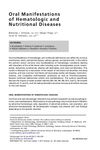TLDR Vitamin A toxicity likely caused the patient's high calcium levels.
A case report from 1982 described a patient with hypercalcemia linked to chronic vitamin A ingestion, presenting with symptoms such as weight loss, psychiatric disturbances, total body alopecia, erosive dermatitis, and liver disease. Elevated total vitamin A levels, particularly retinyl esters, confirmed vitamin A toxicity. Other causes of hypercalcemia were ruled out, leading to the conclusion that the hypercalcemia was most likely due to vitamin A toxicity, highlighting the impact of vitamin A on bone metabolism.
 March 2014 in “Journal of The American Academy of Dermatology”
March 2014 in “Journal of The American Academy of Dermatology” The document lists various dermatology topics, treatments, and diagnostic methods.
 40 citations
,
July 2007 in “Dermatologic Therapy”
40 citations
,
July 2007 in “Dermatologic Therapy” Systemic glucocorticosteroids are a primary treatment for various skin conditions but require careful management due to potential side effects and relapses.
 1 citations
,
January 2021 in “Journal of the Dermatology Nurses’ Association”
1 citations
,
January 2021 in “Journal of the Dermatology Nurses’ Association” The convention discussed various skin conditions and treatments, and highlighted the importance of vaccinations for patients on immune-altering medications.
 24 citations
,
June 2010 in “Clinics in Dermatology”
24 citations
,
June 2010 in “Clinics in Dermatology” Taking too many vitamin and mineral supplements can cause serious health problems.
 50 citations
,
November 2010 in “Otolaryngologic Clinics of North America”
50 citations
,
November 2010 in “Otolaryngologic Clinics of North America” Recognizing oral symptoms can help diagnose and treat blood and nutritional diseases early.




